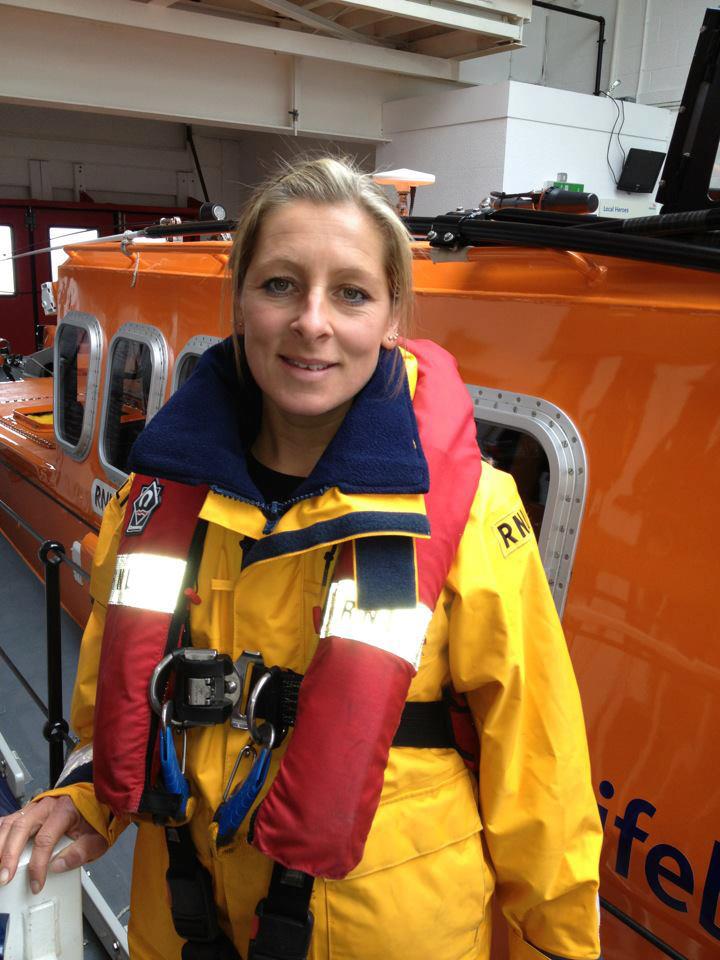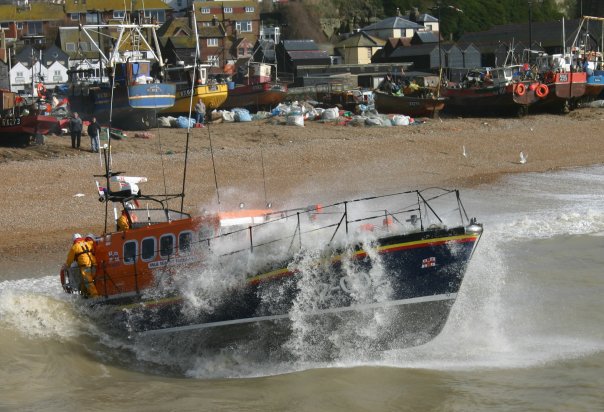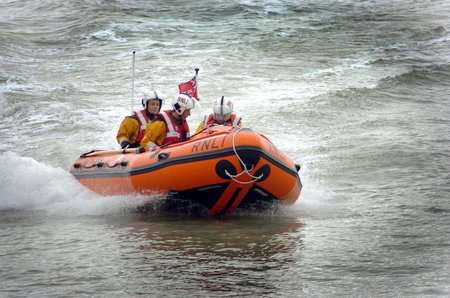|

|
|
Sloane Phillips
Deputy 2nd Coxswain of Hastings Lifeboat
|
You seem to have always had a very close connection to the sea. Was this because you grew up beside the sea or do you have family members who have been sailors?
I have lived in Hastings all my life and I watched the lifeboat launch many times when I was growing up. My mum has been a volunteer in the Lifeboat Shop and Visitor Centre for as long as I can remember and we used to go down to see her when she was working. I remember the excitement of the maroons being fired and the lifeboat launching. I admired the crews that selflessly put to sea in all conditions to help others and loved watching the boat coming back from a rescue. I also remember visiting the station on a school trip and the coxswain at the time telling us about the work of the RNLI and the crews at Hastings. The work of the RNLI has always interested me but I didn’t think one day I would be one of the crew.
I notice you were previously a Beach Lifeguard. Could you tell us a bit more about this? I am curious, why did you choose a job which could put your life into some danger? Did you face any opposition from your family?
I became a member of the local voluntary Lifeguard club when I was 14 and they operated a beach lifeguard service every Sunday throughout the summer months. It was then that I started to patrol the beaches of Hastings as a volunteer and when I was old enough I took my RLSS Beach Lifeguard Qualification which then led to me working full time on the beach at Hastings for the local Council when I left college.
The training and job involved swimming in the sea in different conditions and carrying out different types of rescues. I learnt to respect the sea and understand the varying conditions. I loved how it could go from being beautifully calm one day to turbulent rough conditions the next.
I thoroughly enjoyed every aspect of beach lifeguarding so going out to rescue someone, even in bad conditions, was something that didn’t cross my mind; I just wanted to help people. Most of the work I did as a lifeguard involved carrying out first aid and advising people about the beach and sea but my training really came into force when one day I and a couple of colleagues rescued a man from drowning. It was a horrible shock but to find out he survived made us so happy and made what we did worthwhile.
What lead you to join the Lifeboat service? This is a voluntary position, so what else was going on in your life when you joined?
I wondered if my new found lifeguarding skills would help on the lifeboat so one morning when on one of my patrols I went along to the lifeboat station and after a chat with the coxswain I was asked to join. I was lucky as not only could I volunteer for the RNLI on my days off, the Council allowed me to respond to the pager at work if I could.
It was at this time that I met my husband too; he was a volunteer for Rye Harbour Lifeboat and understood why I volunteered for the RNLI. He soon became a member of the crew at Hastings too and it was great to dash off together when the pagers went off. However, we always knew our roles and responsibilities when volunteering for the Lifeboat and we have a great working relationship. He is now a full time Fleet Staff Coxswain for the RNLI and travels the country covering at different stations and carrying out trial work on new lifeboats and equipment.
 Please could you tell us some more about the work of the lifeboat? For instance I know most of the staff are voluntary - how many people are qualified to act as crew, and how many need to be on board before the lifeboat can be launched? Do you have regular practice days? How much time do you spend on the lifeboat and are there days when the crew are assembled 'waiting for a call out'? Do you have to arrange your summer holidays with your lifeboat duties in mind?
Please could you tell us some more about the work of the lifeboat? For instance I know most of the staff are voluntary - how many people are qualified to act as crew, and how many need to be on board before the lifeboat can be launched? Do you have regular practice days? How much time do you spend on the lifeboat and are there days when the crew are assembled 'waiting for a call out'? Do you have to arrange your summer holidays with your lifeboat duties in mind?
The RNLI is a charity that saves lives at sea; they receive no government funding and rely solely on public donations. They provide an on call 24-hour Lifeboat Search & Rescue service and Flood Rescue Service and a seasonal Lifeguard Service.
All of the team at Hastings are volunteers except for the Coxswain/Mechanic who is a paid full time member of staff. His job is to command the All Weather Lifeboat on Service & Exercise, maintain the machinery, plant and equipment at the station and in his absence he has 3 Deputy Coxswains & 3 Deputy Mechanics.
The volunteer crew is made up of guys & girls from all different walks of life. We have shop keepers, a window fitter, an Accident & Emergency Doctor, a Motorcycle shop owner, a civil servant and even an arbor culturist to name a few.
The D-Class Inshore Lifeboat carries out mainly inshore rescue work, for example swimmers, windsurfers, inflatable dinghy’s and small craft/fishing boats. The crew is normally 2 or 3 people as long as one of them is a Helmsman and responds to calls within a few minutes.
The Mersey Class All Weather Lifeboat carries out jobs in all conditions and responds to a variety of calls, for example fishing boats, commercial ships, medical jobs, yachts and pleasure craft etc. The crew is normally 5 or 6 people including a coxswain & mechanic. The crew carry out all sorts of duties including deck work, radar, navigation, helming the boat and look out.
All of the crew carry pagers and if we are free to respond when a call comes in from The Coastguard we start heading for the station. We could be asleep in our beds, out for a meal, at a party or at work, the crews are very dedicated. The D Class launches as soon as the crew arrive (as long as one is a helm) and the Mersey crew is picked by the coxswain depending on the job and crew competencies.
All of the crew start as shore crew and once they settle in they are asked to go on the seagoing crew. This is where they start their training and as well as on station training and exercises they can attend the Lifeboat Training College in Poole, Dorset and take a Sea Survival course, Basic Crew courses, First Aid and many more.
It’s a fair commitment being part of a lifeboat crew. At Hastings we exercise with the boats every fortnight and we have shore based crew training every Wednesday where we carry out training and exercises on all aspects of lifeboat work, for example radar, navigation, first aid, and rope work practice and engineering and maintenance.
The RNLI provide a great training programme and over the years I have progressed well, attending many different courses with the RNLI. These included Powerboat Level 2, Long Range Radio, Navigation & Radar Courses, Search & Rescue Command and Yacht master.
Being a Deputy 2nd Coxswain I commit to being on call in the absence of the coxswain, if he is sick or on leave for example. This means I have to be able to respond if the pagers go off and can’t go very far from the station. It’s a big commitment.
I am very curious about the life of a woman in a lifeboat crew. Are there any other women in your crew? Have you ever felt that being a woman put you at a disadvantage? Would you recommend joining the Lifeboat service to other women?
The RNLI is a very traditional organisation and when I joined I was the only female at Hastings, I never thought they would let a girlie in! I admit I was apprehensive; however, I was lucky at Hastings as there had been a female crew member at the station a few years before me. I was made to feel really welcome and soon became part of the team and I thoroughly enjoyed it.
Today at Hastings there are two females on the crew and two on the launch crew and over 200 within the RNLI.
 You quickly qualified as a lifeboat helmsman, then a navigator and now you are a coxswain. Do you have any unfulfilled ambitions?
You quickly qualified as a lifeboat helmsman, then a navigator and now you are a coxswain. Do you have any unfulfilled ambitions?
With hard work and commitment I progressed into command positions on the lifeboat, this has made me very proud. I honestly didn’t think that when I joined I would be a deputy coxswain but after 17 years I am really happy to be in the roles I am at Hastings.
I know you have qualified as a Paramedic with the lifeboat service, and you are also a paramedic in your paid career.
Please could you tell us something of your regular job - do you work on the ambulances? How would you describe your job? Are there many female paramedics?
I am a full time Paramedic for South East Coast Ambulance Service and I have been part of their Hazardous Area Response Team for the last 3 years. HART teams are comprised of specially recruited and trained personnel who provide the ambulance response to particularly hazardous or challenging incidents and in some cases where there is a mass casualty, CBRN, Large Fires or Search & Rescue incidents. I also respond to regular 999 calls single manned in a response car or as part of a crew on an ambulance. This means I never know what my next job will be and it may be anything from an elderly patient that has fallen to a patient having a stroke or a heart attack, to Road Traffic Crash or child. However, I recently passed an assessment day and Interview for the Helicopter Emergency Medical Service (HEMS) and I start my training in February. I will be based in Kent but the service provides Paramedic and Doctor cover to all of Kent, Sussex and Surrey.
I see you recently joined an International Flood Rescue Team. Could you tell us something about this sort of work?
I am also a volunteer on the RNLI’s National & International Flood Rescue Team. The National Team is available 24 hours a day, 7 days a week, to deploy to flooding events in the UK, Ireland. The team comprises lifeboat crews from all around the RNLI, who have been specially trained for the risks involved when working in or around fast moving flood water. The team was formed in 2000, and we now have six divisional teams strategically positioned to respond to a flood anywhere in the UK or the RoI within 6 hours – a total of 250 team members. The RNLI’s international Flood Rescue Team (iFRT) is a group of approximately 50 specially trained RNLI lifeboat men and women who have volunteered to be ready to travel anywhere in the world to assist in flood relief work. We have additional skills for working overseas, including previous experience in developing countries and disaster zones, as well as specific skills such as being a doctor, paramedic, linguist or mechanic. We always have to ensure we have all our necessary vaccinations up to date and a bag packed to enable us to deploy at a moment's notice.
Do you have a favourite memory from your time in the RNLI? For instance from the celebrations of the Queen Mother's 100th birthday or from the celebrations for Hastings Lifeboat 150th birthday? Or possibly you were involved this summer with Queen's Jubilee or the Olympics?
I have many fond memories of my time with the RNLI, from my first job on the inshore lifeboat, to representing the RNLI at the Queen Mothers 100th Birthday Celebrations in London in 2000 and taking part in Europe’s biggest ever Flood exercise in Holland with the Flood Rescue Team in 2009. I was also proud to receive a Framed Letter of Thanks from the RNLI’s Chairman in 2006 after a service on the Inshore Lifeboat which saw our Senior Helmsman awarded a ‘Thanks of the Institution’ inscribed on Vellum. It was for the rescue of a swimmer from the sea and the D class lifeboat was operating in the surf at the limit of its capability in heavy 3m-high seas, it was a tough job.
I am very proud to be a volunteer for the RNLI and to be able to do something to help others. The training is second to none, the teamwork at the station is fantastic and I have made so many new & lifelong friends over the years. We all get on immensely well and enjoy every aspect of our RNLI work, from the training, to the service calls and the socialising.
Is there anything else you would like to share with us?
In my spare time (when I do get some) I love spending time with my husband, walking our dogs over the local country park, socialising with friends and taking the opportunity at least once a year to head for the slopes and enjoy a week or so snowboarding.
| Short Biography |
|
Sloane Phillips has worked for South East Coast Ambulance Service NHS Trust since 2002 qualifying as a Paramedic in 2007 and has just started a 3 year secondment to the Kent Sussex & Surrey Air Ambulance Trust. They are a registered charity established to relieve sick and injured people in South East England and surrounding areas by providing a Helicopter Emergency Medical Service (HEMS). They respond swiftly to 999 calls and deliver a highly skilled team of Specialist Doctors and Critical Care Paramedics to the patient at the scene.
Sloane completed a Foundation Degree in Paramedic Science through St Georges University of London & has also completed a Mentorship Preparation module at BSC Level 6 through Brighton University. The mentorship qualification allows her to mentor in service and external Paramedics through their course and progression with the Trust.
Prior to her HEMS position Sloane spent 3 years with the Hazardous Area Response Team (HART) gaining several other specialist Rescue Paramedic qualification and Safe Working at Height. This allows her to work in hazardous areas such as collapsed buildings, confined space rescue and at height. Sloane has been a volunteer crewmember with the Royal National Lifeboat Institution (RNLI) since 1997 and holds the Deputy 2nd Coxswain and Inshore Lifeboat Helmsman at Hastings Lifeboat
Station. She is also a member of the RNLI’s National.
Sloane is passionate about her work with the RNLI & the Air Ambulance and is honoured to be a representative for two such high profile charities.
Contacts:
Sloane Phillips,
Hastings Lifeboat Sta
The Stade, Hastings, East Sussex, UK TN34 3AL
www.hastingslifeboat.org.uk
|
Disclaimer -
Any views and opinions presented in this article are solely those of the author and do not necessarily reflect those of RNLI, nor do they constitute a legally binding agreement.
.png)
.png)